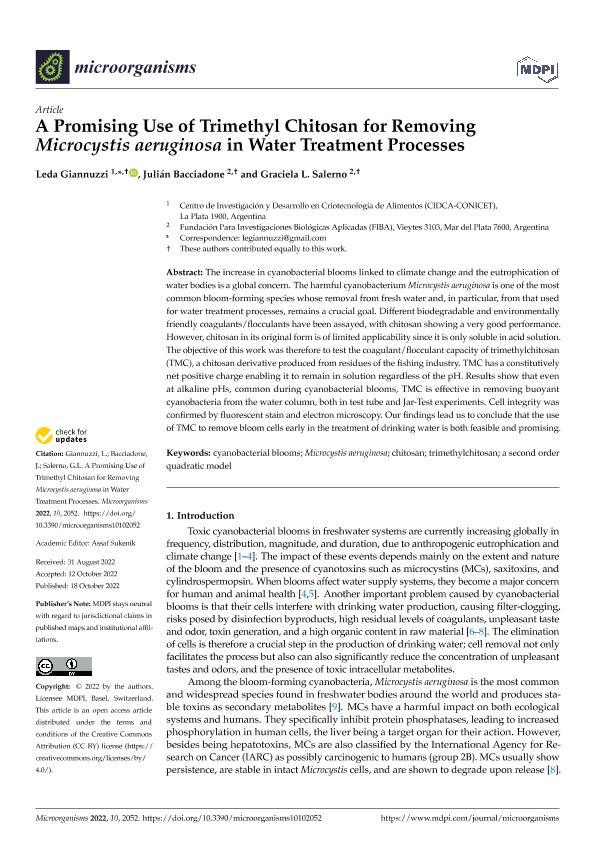Artículo
A Promising Use of Trimethyl Chitosan for Removing Microcystis aeruginosa in Water Treatment Processes
Fecha de publicación:
10/2022
Editorial:
MDPI
Revista:
Microorganisms
ISSN:
2076-2607
Idioma:
Inglés
Tipo de recurso:
Artículo publicado
Clasificación temática:
Resumen
The increase in cyanobacterial blooms linked to climate change and the eutrophication of water bodies is a global concern. The harmful cyanobacterium Microcystis aeruginosa is one of the most common bloom-forming species whose removal from fresh water and, in particular, from that used for water treatment processes, remains a crucial goal. Different biodegradable and environmentally friendly coagulants/flocculants have been assayed, with chitosan showing a very good performance. However, chitosan in its original form is of limited applicability since it is only soluble in acid solution. The objective of this work was therefore to test the coagulant/flocculant capacity of trimethylchitosan (TMC), a chitosan derivative produced from residues of the fishing industry. TMC has a constitutively net positive charge enabling it to remain in solution regardless of the pH. Results show that even at alkaline pHs, common during cyanobacterial blooms, TMC is effective in removing buoyant cyanobacteria from the water column, both in test tube and Jar-Test experiments. Cell integrity was confirmed by fluorescent stain and electron microscopy. Our findings lead us to conclude that the use of TMC to remove bloom cells early in the treatment of drinking water is both feasible and promising.
Archivos asociados
Licencia
Identificadores
Colecciones
Articulos(CCT - MAR DEL PLATA)
Articulos de CTRO.CIENTIFICO TECNOL.CONICET - MAR DEL PLATA
Articulos de CTRO.CIENTIFICO TECNOL.CONICET - MAR DEL PLATA
Articulos(CIDCA)
Articulos de CENTRO DE INV EN CRIOTECNOLOGIA DE ALIMENTOS (I)
Articulos de CENTRO DE INV EN CRIOTECNOLOGIA DE ALIMENTOS (I)
Citación
Giannuzzi, Leda; Bacciadone, Julián Andrés; Salerno, Graciela Lidia; A Promising Use of Trimethyl Chitosan for Removing Microcystis aeruginosa in Water Treatment Processes; MDPI; Microorganisms; 10; 10; 10-2022; 1-15
Compartir
Altmétricas




